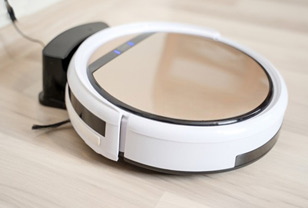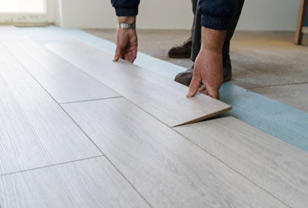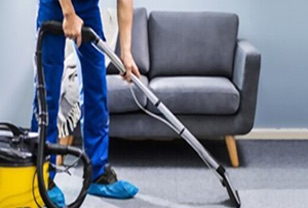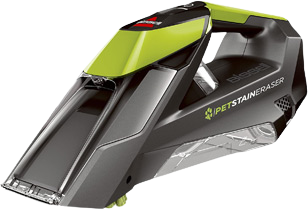How to Prevent Footprints on Laminate Floors: The Complete Expert Guide for Every Home
In this expert guide from TheKingLive, our home care editors share proven routines that keep footprints from coming back and help you maintain clear finishes on laminate flooring without constant scrubbing. Everything below is practical, repeatable, and safe for most laminate products when used correctly.
Quick Fix: The Short Version of Preventing Footprints
When you need fast results, a simple sequence works best: remove dry grit first, lift residues with a low-moisture pass, then dry the surface quickly so nothing streaks. These steps do not require special tools and are easy to repeat on busy days. Think of this as your “reset” when prints suddenly appear in bright light.
Do this now
-
Empty and rinse your bucket, or use a clean spray bottle.
-
Fit a flat microfiber mop with a fresh pad.
-
Mix a pH-neutral laminate-safe cleaner with distilled water per label directions.
-
Lightly mist the floor or the pad (do not pour on the floor).
-
Keep the pad only slightly damp; never dripping.
-
In stubborn zones, spot-treat with a 50:50 blend of warm distilled water and either saline solution or odorless mineral spirits; always spot-test first.
-
Let the surface air-dry fully before any bare-foot traffic.
Slippery residue forms a film when it dries, which makes prints visible. Your goal is to prevent that film from forming—or, at minimum, make it easy to remove so light no longer catches on it.
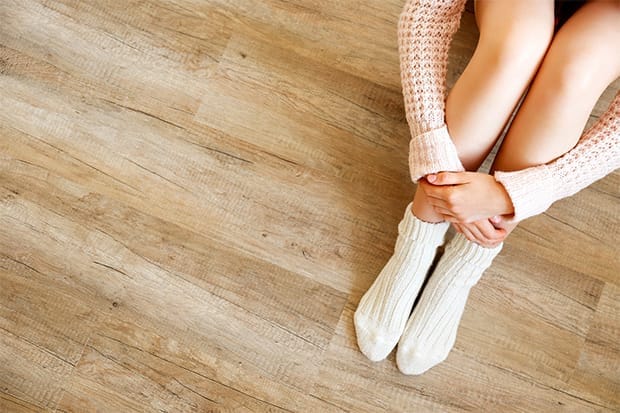
Unless you wear socks or slippers all the time, you can easily leave footprints on the laminate floor
Major Streak-Free Agents and Essential Tools
You do not need industrial equipment to keep laminate clear and calm. The right lightweight tools, paired with a consistent routine, outperform expensive machines that can over-wet the surface. Start with a small, reliable kit you can grab at any time; consistency beats intensity here.
Core kit
-
Flat microfiber mop with replaceable pads
-
Microfiber floor cloths or wipes for edges and corners
-
pH-neutral laminate-safe cleaner
-
White vinegar for very light residue (used sparingly in a dilute mix)
-
Warm distilled water to minimize mineral spotting
-
Saline solution or odorless mineral spirits for stubborn, oily films
-
Small spray bottles for targeted cleaning

Vinegar is not only good for cooking but also good for cleaning footprints on your laminate floor
Helpful add-ons
-
Light glass or window cleaner for oily shoe marks near exterior doors
-
Acetone-based nail polish remover for waxy buildup in tight crevices
-
Robot vacuum for hands-off dust collection in high-traffic homes
Always ventilate when using any solvent such as mineral spirits or nail polish remover, keep away from flame or heat, and spot-test in an inconspicuous area. Check your laminate care manual and warranty language before introducing new products.
The two pillars of footprint prevention are simple: use the right products and follow a routine you can keep every week. Invisible prints are usually a thin oil film. Either stop that film from building up, or break it apart before it catches the light.
Choosing Your Cleaner So That Footprints Never Come Back
Product choice often decides how to prevent footprints on laminate floors and whether they appear again just two hours after you mop. Many “add-shine” formulas marketed for quick gloss contain waxes, silicones, or polymers that form a soft film on the wear layer. That film attracts dust, holds body oils, and highlights every step under direct light. A clear, natural look—not a wet, glassy shine—is typically the finish laminate is designed to maintain.
Before listing specific do’s and don’ts, it helps to frame your selection process. Read labels, but trust testing more than claims. Light, residue-free performance under your home’s lighting is the real standard.
What to look for
-
pH-neutral, no-wax formulas labeled safe for laminate or hardwood
-
Low-residue liquids (not powders or scrubbing creams)
-
Nonabrasive ingredients that will not scuff the wear layer
-
Mild, non-lingering scent that does not irritate
What to avoid
-
High-oil, high-gloss treatments that promise a "wet look" or intense sheen
-
Paste polishes, rejuvenators, or restorer coatings designed to leave a film
-
Harsh solvents used across large areas without guidance from the manufacturer
Always test first
-
Choose a hidden patch, let it air-dry completely, and then walk on it with dry socks.
-
Check the area under bright daylight or a strong lamp.
-
If it looks hazy or feels tacky, choose a milder alternative or a simple DIY mix.
If, after drying, the patch transfers residue to socks or cloth, that residue will collect dust and become visible prints later. A persistent white mist is almost always leftover film.
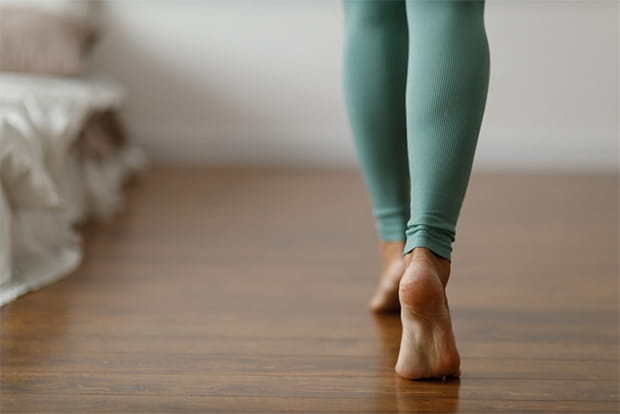
Instead of trying to tip-toe so that you won’t leave footprints on the laminate floor, learn how to clean them correctly
Establish a Laminate Cleaning Routine
Footprints are easiest to prevent with frequent, light maintenance rather than rare, heavy scrubbing. A routine that fits your household keeps surfaces clear without turning cleaning into a project. The principle is simple: dry removal first, low-moisture cleaning second, quick drying third.
Suggested weekly rhythm
-
Every 2–3 days: Vacuum or dust high-traffic paths in hallways, entries, and around the kitchen island.
-
Weekly: Vacuum bedrooms, guest rooms, and home office; then do a flat-mop pass with a pH-neutral cleaner.
-
As needed: Spot-clean oily prints by doors or pet zones with a microfiber cloth and a light spray.
Before any damp pass, remove grit and crumbs so you do not grind micro-scratches into the wear layer. If time is tight, prioritize entry, kitchen, and living areas where shoes are used and oils transfer most.
Household photos and real-home observations consistently identify the same trouble zones: the lanes around sofas and coffee tables, the perimeter of a kitchen island, and the strip inside back or patio doors. These are the first places to focus when prints reappear.

A flat mop is better for cleaning the laminate floor
How to Stage Your Weekly Clean
Set yourself up so each step flows into the next without backtracking. Two extra minutes of prep usually prevents fifteen minutes of rework.
Step 1: Dry Prep
-
Run a robot vacuum on a schedule, or do a fast stick-vac pass.
-
Use a soft brush to lift dust from baseboards and stair nosings.
-
Shake and launder small mats so they can capture fresh dirt later.
Step 2: Damp Clean
-
Install a clean microfiber pad and lightly mist it with your diluted cleaner.
-
Work in plank-length strokes, following the grain direction.
-
Rinse or swap the pad as soon as it looks gray; a dirty pad only smears residue.
Step 3: Fast Dry
-
Open windows when weather allows, or run a fan or AC for airflow.
-
Keep foot traffic off the area until it looks uniformly dry and clear.
-
Inspect the surface under strong light; if streaks remain, repeat with a fresh pad.
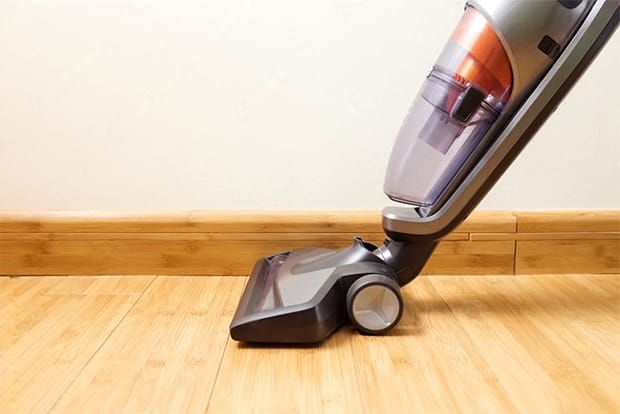
Not doing a vacuum session before mopping can create scratches on your laminate floor
Targeted Film-Lift Recipe for Stubborn Lanes
Even with good habits, certain lanes can keep showing marks—usually where bare feet land after the shower or near doors that get humid outside air. A short, targeted treatment helps reset those patches without coating the entire floor. Use sparingly and only after a normal pH-neutral clean.
Mix for problem spots
-
50 percent warm distilled water
-
50 percent saline solution or odorless mineral spirits
Why it works
-
Saline helps loosen light body oils and residues without harshness.
-
Mineral spirits break down oily film, waxiness, and old cleaner buildup that standard mopping cannot lift.
How to apply safely
-
Lightly dampen a microfiber pad or cloth—do not soak the surface.
-
Work in small, manageable squares.
-
Immediately follow with a damp pass of pH-neutral cleaner to remove any trace.
-
Ventilate well and keep flames or heat sources away from solvents.
A Simple Three-Night “Proof Test”
If you are unsure whether residue is the root cause, run this quick experiment in a single room. It confirms the problem and calibrates your cleaner to your home’s lighting and humidity.
Night 1
-
Dry prep thoroughly.
-
Do a low-moisture, pH-neutral pass with a clean pad.
-
Air-dry and block traffic for 30–60 minutes.
Night 2
-
Repeat Night 1, then buff lightly with a dry microfiber towel to remove any faint streaks.
-
Check the surface at multiple angles of light.
Night 3
-
Spot-treat only the lanes that still catch light with the film-lift recipe.
-
Follow with a neutral cleaner pass and fast-dry again.
If the room looks clearer after Night 3, residue was the main culprit and your weekly routine will hold the gain. If prints persist, review habits that quietly add haze.
Hidden Habits That Damage Laminate
Even solid routines can be undone by a few common missteps. These issues are easy to miss because they show up gradually as light haze, then suddenly become obvious when the sun moves across the floor. A small correction here often delivers the fastest visible improvement.
Mistake 1: Using String or Sponge Mops
These hold excess water and push dirty solution into the joints, creating cloudy halos and, in the worst cases, causing edge swell. If you’re asking how to prevent footprints on laminate floors, switch to flat microfiber mops that apply even pressure, use less water, and let you swap dirty pads for clean ones. Replace gray pads promptly; a gray pad is a spreading pad, not a cleaning pad.
Mistake 2: Leaving Water Behind
Standing liquid seeps into joints and dulls the surface. Wring the pad well so it is damp, not dripping. Wipe spills immediately instead of chasing them with a wet pad. Blot sticky stains with a cloth and avoid scrubbing one spot repeatedly; a targeted wipe plus a fresh pad beats aggressive rubbing.
Mistake 3: Using Film-Forming “Shine” Products
High-gloss products can attract dust and pet hair, show streaks in direct light, and build a stubborn haze. Laminate looks best with its natural, factory finish. Choose pH-neutral, nonabrasive, low-residue cleaners. If prints get worse right after switching products, you are likely seeing leftover film rather than dirt.
Mistake 4: Skipping Vacuuming
Grit makes micro-scratches that trap residue and scatter light. A two-minute vacuum pass saves you from chasing dullness later. It also lets your cleaner act on real residues instead of sand. If you own a robot vacuum, schedule it for late afternoon so lanes are clear before evening mopping.
Customize Your Routine to Your Home
Every home has different traffic patterns, humidity levels, and lighting. Adapting the same core method to your layout ensures the routine feels natural and sustainable. When a routine fits your day, consistency rises—and prints fade.
Homes with Children
Use runners on heavy pathways, especially between bedrooms and bathrooms or from the sofa to the kitchen. Place a small washable mat in play zones so kids can quickly wipe feet or catch snack crumbs. Expect more frequent quick sweeps; the payoff is fewer deep cleans and a calmer look in daylight.
Pet Considerations
Trim nails to reduce scratching and snagging on edges. Use a robot or regular vacuum on a set schedule to keep fur and dust from bonding with body oils into a visible film. Add washable mats at main doors to capture moisture and dirt before it hits laminate.
Small Apartments
Focus on the entry and the core living area because the same few boards see every step. Keep a spray mop loaded with a mild pH-neutral solution for two-minute touch-ups. A single fresh pad and a lap around the sofa lane can eliminate the day’s prints.
Brand-New Laminate
Avoid heavy waxes, high-gloss, and “wet look” products from day one. Follow the manufacturer’s care guide, especially for compatibility notes. Start with mild pH-neutral cleaners and a flat microfiber mop, observe results for a few weeks, and only introduce specialty spot-treatments if needed.
Spot-Cleaning Guide for Common Print-Causers
A handful of residues cause most footprint complaints. Addressing them directly prevents re-soiling and restores a uniform look in strong light. Always start with the mildest option, then step up only as needed.
Oily Bare-Foot Prints Near Bathrooms
-
Wipe with a lightly damp microfiber cloth and a pH-neutral cleaner.
-
If sheen remains, mist a vinegar-light mix (3 cups warm water with 1/2 teaspoon white vinegar), wait 3–5 minutes, then buff dry.
-
For stubborn patches, do a single pass with the film-lift recipe and follow with a neutral clean.
Shoe Marks by Exterior Doors
-
Try a small spritz of light glass cleaner on a cloth (not on the floor), rub gently, then neutral-clean.
-
Add a boot tray or washable mat to intercept moisture and grit.
Waxy Specks in Tight Corners
-
Touch a cotton pad with acetone-based nail polish remover and work in small circles.
-
Immediately wipe with a damp microfiber cloth and then dry.
-
Keep acetone and window cleaner separate; use them only where needed.
Lighting, Humidity, and How Floors “Read”
Footprints are not just about soil; they are also about optics. Strong side-light from low windows exaggerates streaks and prints. Dry winter air can make residue feel tackier; humid summer air can soften films so they grab dust. Simple environment tweaks help floors “read” clean.
-
Rotate or tilt blinds to reduce extreme side-glare on long planks.
-
Keep indoor humidity in a moderate range where your flooring warranty recommends.
-
Use entry mats that actually get used; size them so the first three steps land on textile, not laminate.
Maintenance Calendar You Can Keep
Consistency beats perfection. Use this lightweight cadence and adjust up or down based on how your floors look and how your household moves.
-
Daily (busy homes): Quick spot wipe of visible lanes, especially by doors.
-
Every 2–3 days: Vacuum or dust high-traffic areas.
-
Weekly: Full flat-mop pass with pH-neutral cleaner and fresh pads.
-
Monthly: Inspect trouble zones under strong light and run the film-lift recipe only where needed.
-
Seasonally: Launder or replace entry mats, wash mop pads thoroughly, and check care labels against any new products you plan to try.
Footprint Prevention Checklist
-
Vacuum or dust before every mop.
-
Use a flat microfiber mop with clean pads.
-
Choose a pH-neutral, no-wax, residue-free cleaner.
-
Keep moisture minimal; never flood.
-
For stubborn film, spot-treat with a 50:50 saline or mineral spirits mix, then neutral-clean.
-
Let floors dry completely before foot traffic, especially bare feet.
-
Ventilate when using any solvent and always spot-test.
-
Follow manufacturer guidance before using any solvent or steam.
Final Words: Cleaning Floors with Minimum Effort
Small changes deliver big results for anyone asking how to prevent footprints on laminate floors. Vacuum first, then damp mop with a pH-neutral cleaner and a fresh pad. Test a mild vinegar-light mix in one room for haze only, and reassess under bright light after a few days. Many households report fewer streaks, softer glare, and far fewer visible footprints once moisture and residue are controlled.
If you want practical, real-home advice on laminate care, tested by everyday users and reviewed by editors, explore the guides by TheKingLive and refine your routine. With the right tools and a steady rhythm, your laminate can stay clear, calm, and footprint-free day after day.
FREQUENTLY ASKED QUESTIONS
- 01. Can I Use Vinegar As My Main Cleaner On Laminate?
-
Use vinegar only in very light, well-diluted mixes for specific haze removal. As a daily cleaner, it can be too acidic and may dull the finish over time. A pH-neutral, laminate-safe cleaner is the better everyday choice.
- 02. Will Steam Mops Remove Footprints Faster?
-
Most laminate manufacturers do not recommend steam because heat and moisture can stress joints and cloud the wear layer. Stick to low-moisture, pH-neutral cleaning and targeted film-lift steps.
- 03. Why Do Prints Show Up Only In The Afternoon?
-
That is when low, strong light rakes across the planks, amplifying streaks and fine residue. If your floor looks perfect at noon and hazy at 4 p.m., you are seeing optics plus a thin film. Adjust blinds and run a quick pad-swap pass in those lanes.
- 04. Do I Need To Reseal Laminate To Stop Prints?
-
Laminate has a factory wear layer and is not meant to be waxed or top-coated like site-finished wood. If prints persist after residue control, revisit product choice and pad cleanliness; coatings often make the problem worse.





